adriaticnature is sure that there is nothing better than adopting fishing experience, bringing it to familiar waters from other lands, or rather, water bodies. It enables you to change a conventional approach to fishing and, often, to increase the efficiency of fishing trips. And, of course, it helps to get an idea of what tackle and lures should be taken if you go on a trip and happen to have idle moments for fishing in a particular country.
When you think about fishing in Great Britain, or rather in England, the first thing you imagine is pictures, drawings and black-and-white photos of fishermen casting midges into river rapids and waiting for trout to bite. However, Great Britain is an island country washed by the seas. Trout is good, but adriaticnature asked an amazing angler, Virgis Ruksnaitis, who has been living in England for a long time, to talk about sea fishing of predatory fish from the shore and to make it clear whether one should plan on sea fishing in England when occasion serves.

(Virgis Ruksnaitis with a ballan wrasse. Photo by © Virgis Ruksnaitis)
Hello, Virgis! Thanks for taking the time to have a conversation with us! Probably, any angler with a spinning rod can’t help but drool over the splendid wrasses that you catch from the shore all the time! But let’s start from the very beginning. Does a visiting angler need a license for fishing on the sea?
Greetings to the adriaticnature readers! Starting from the very beginning and briefly speaking – you don’t need licenses for sea fishing in England.
What nuances should anglers know if they decide to go fishing with a spinning rod on the seashore in England?
The nuances, as usual, include only the bottom topography features in the places of fishing. If you decide to spend some time fishing near the sandbanks or just settle down next to the sandy beaches, then you should expect to catch sea basses. If you fish in the places where large stones are scattered at the bottom, then it makes sense to focus on wrasses.

(Ballan wrasse. Photo by © Virgis Ruksnaitis)
But not only sea basses and wrasses swim close to the shore, don’t they? What other fish species can be caught with spinning lures?
Of course, fishing is not limited to two fish species. You should keep in mind that our seas are quite cold, and chances to have a wider “range” are higher when the water becomes warmer in summer. Especially, if you like a light tackle. In addition to sea basses, garfishes, horse mackerels are active as well. If you are a fan of fishing with “UL”, “ultralight” class lures, and come with a spinning rod with the corresponding test, for example, of up to 5 grams, then you can catch large gobies and scorpionfishes.

(Garfish, caught with a jig. Photo by © Virgis Ruksnaitis)
Great Britain, more than any state in the world, is trying to maintain a sea bass population. In theory, this should have an impact on its quantity and quality. Is that true? Should fishermen expect to catch trophy sea basses in England?
Yes, it’s great that the state protects this wonderful fish. And every fisherman with a spinning rod who knows at least the basic peculiarities of catching this predator has a chance to catch “decent” sea basses. There are restrictions – a fisherman can take only one fish at least 42 centimeters long. My greatest achievement is a sea bass weighing 3.5 kilograms. And this sea bass is rather small by English standards, since the heaviest recorded sea bass, which was caught in England, is 8.93 kilograms.
Specimens weighing from two to three kilograms are often caught from the shore in summer. If you fish from the boat, you may catch bigger sea basses weighing from three to five kilograms. Currently, catching sea basses on the beaches at night in summer is quite a popular hobby among anglers.

(Sea bass. Photo by © Virgis Ruksnaitis)
To what extent is “shore jigging” popular and developed in the UK?
Shore jigging is just beginning to develop in England. Besides, engaging in sea spin fishing is a novelty for English anglers, one might say. Of course, shore jigging brings diversity to the fish species range that may be caught. For example, a lot of large haddocks can be caught from the shore.
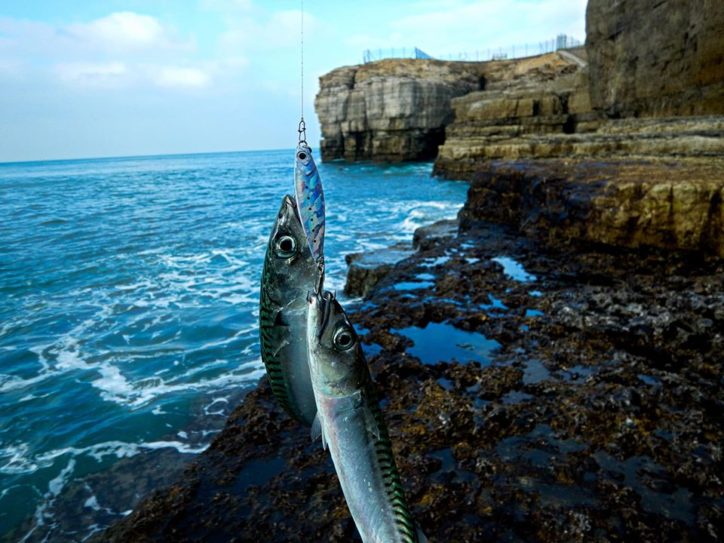
(Mackerels, caught with a jig. Photo by © Virgis Ruksnaitis)
Tell us, please, a few words about catching wrasses. Where should fishermen look for them? What are the best lures for them to respond to?
Wrasses are my favorite fish to catch. I’ve been catching them with great pleasure for the past four years or even more. These fish can weigh up to 4.5 kilograms in our part of the world, at least this is a record-breaking specimen caught in England. The largest fish I caught weighed about three kilograms. These fish are very strong and bold opponents!
Wrasses prefer swimming among large stones and close to the bottom covered with underwater vegetation, at least in the southern part of England, where I catch them.
I use mainly rather compact soft plastic lures – at the beginning of the season, in April, about five centimeters long, later – about seven. So far, Lunker City Slug-Go 3” has been my favorite. It is a versatile lure that brings me good specimens all year round. Various imitations of worms and crabs work well in summer. For example, Z-Man CrawZ TRD.

(Ballan wrasse. Photo by © Virgis Ruksnaitis)
What rods and reels do you use for fishing on the sea?
So far, I’ve opted for several rods. In summer, when fish swim close to the shore and long casts are not required, I use Tict Sram TCR-84S Reloaded with a test of up to 12 grams, with an excellent hard blank. In September, large fish swim closer to the shores, and I take a more powerful spinning – Tict Ice Cube Rockin Power IC-86 with a test of up to 18 grams.
A fishing rod for catching wrasses should be powerful, but at the same time, a test of lures being cast should be fairly light. The first seconds of restraining the resistance of the fish are crucial, it tries to escape and hide under the stones, and if your rod is “slow”, most likely you won’t win the fight, you can lose the fish with the lure.
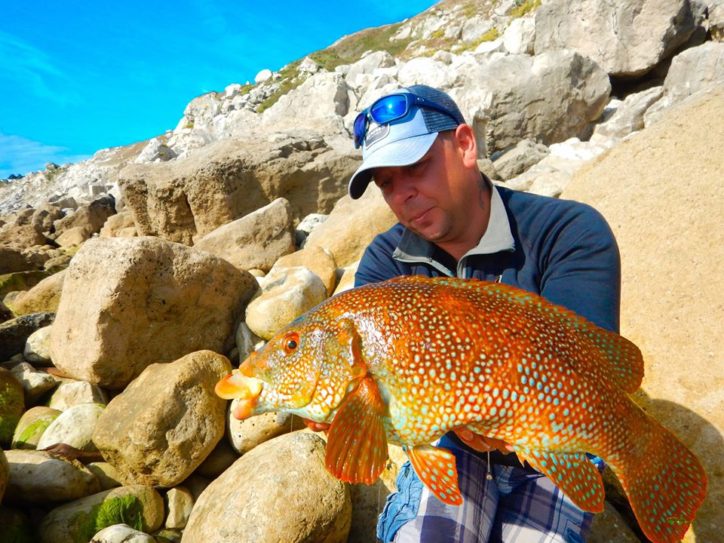
(Ballan wrasse. Photo by © Virgis Ruksnaitis)
Should guests plan on fishing from the boat? Is there anything that can surprise inexperienced anglers?
Personally, I don’t like fishing from boats. Indeed, the fish are larger, the species diversity is quite large as well. But this is not my cup of tea. But I can recommend it to those who really want it.
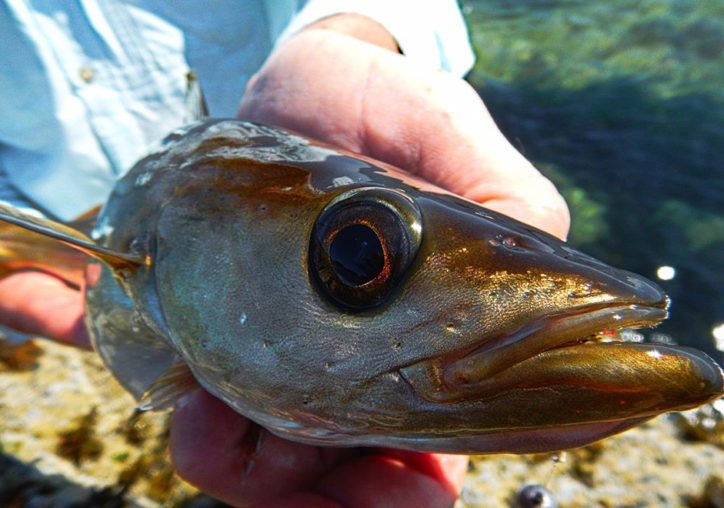
(Haddock, caught with a jig. Photo by © Virgis Ruksnaitis)
Not asking a question about salmonids would be wrong. Mouths of the rivers flowing into the sea are an excellent position for catching them. Is it possible to catch them? What do the laws state as regards catching them?
The laws state that one requires a license for catching fish of the Salmonidae family. It can be bought at post offices. And it’s better to aim for fishing in Scotland instead of England. But having bought a permit at the post office, you have to buy another permit – the one from the club that controls a particular section of the river. And such a permit may be quite expensive, everything depends on how large the population of salmon fishes in this place is. Such pleasure can cost £ 300 – £ 400 per day of fishing. And, in most cases, fishing is based on the “catch-and-release” principle.
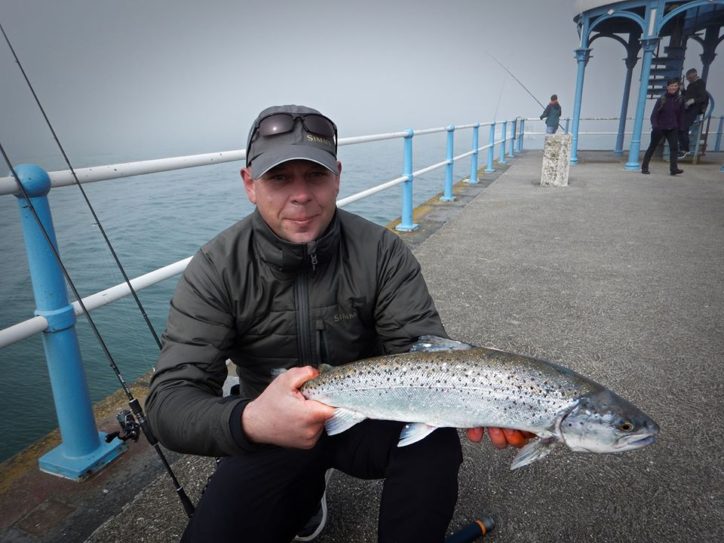
(Sea trout. Photo by © Virgis Ruksnaitis)
What can you wish the adriaticnature readers that are going to have a trip to England and looking forward to catching predatory fish from the shore?
Of course, I wish them catching big and beautiful fish! And be sure to take all the tackle you need! Feel free to contact me about fishing in England, you can easily find my personal profile on Facebook. And I will always be happy to answer your questions.
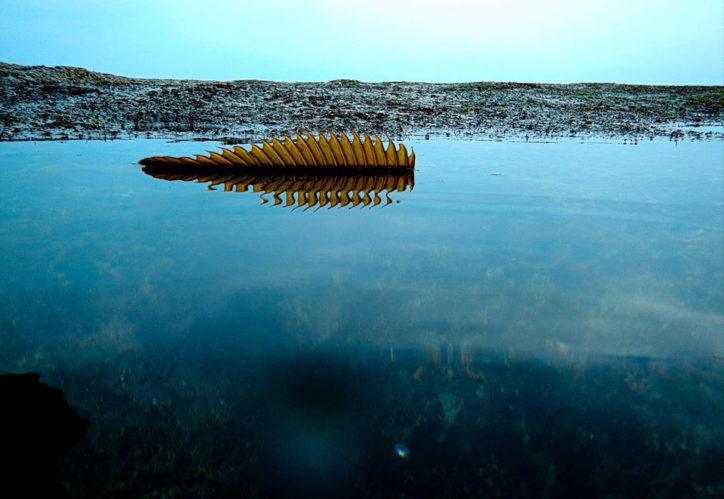
(Ballan wrasse. Photo by © Virgis Ruksnaitis)